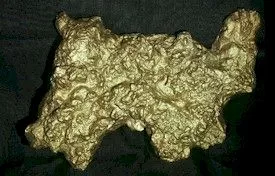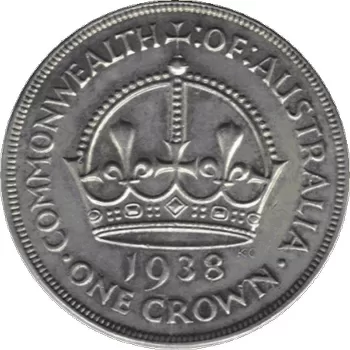The largest gold nuggets ever discovered are remarkable not only for their size but also for their rarity and value. Gold nuggets are highly sought after by collectors and can hold significant value beyond their weight in gold due to their historical and aesthetic significance.
Here are a few of the most famous and largest gold nuggets:
The Welcome Stranger
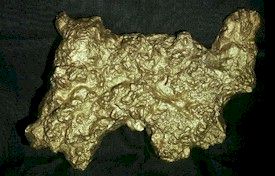

The world’s largest recorded alluvial gold nugget is “The Welcome Stranger”. The huge gold nugget was found by gold miners John Deason and Richard Oats on 5th February, 1869 at Black Lead, Bull-dog Gully, Moliagul in Victoria, Australia.
The gold nugget was broken up on an anvil to be weighed at nearby Dunolly in Victoria, Australia.
The Welcome Stranger nugget weighed 2316 troy ounces (about 72 kg) and at the time of discovery was the largest known gold nugget in the world, measuring 60 by 45 by 19 centimetres. The site of discovery is marked by a stone monument.
Working his claim, Deason broke his pick when it struck something hard just under the earth’s surface. Thinking it was a boulder, he tried to prise it out of the earth but broke the pick handle trying to get it out.
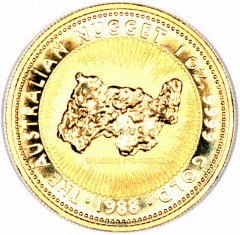

When he eventually got it out of the earth, he discovered it was a massive gold nugget – the largest in the world.
John Deason and Richard Oats were paid 19,068 pounds for the nugget.
The publication “Gold Nuggets of Victoria” from the Department of Mines, Melbourne, Victoria lists the price of gold at the time as four pounds, one shilling and sixpence, noting that the cheque for the nugget amounted to nine thousand, five hundred and eighty three pounds, which equals 2,380 ounces.
Deason and Oats broke pieces off the main nugget, which explains the discrepancy in the amount paid. The main entire nugget weighed 2,284 ounces and additions from the original find but not still attached accounted for the total presented to the bank.
°. °. °. °.
The Welcome nugget
The “Welcome Nugget” was found on 9th June, 1858 at Bakery Hill, Ballarat, Victoria at a depth of 180 feet by the Red Hill Mining Company.


A party of 24 worked the claim and therefore all claimed part of the fame involved in unearthing a gold nugget weighing 2,217 troy ounces (about 71.3 kg) and 16 dwts.
The Welcome gold nugget measured 53 by 28 by 16 centimetres and was assayed at over 99 per cent pure gold.
After refining it yielded 2,195 ozs. of fine gold. Comparatively its fame was short lived.
The nugget was exhibited in Melbourne for many weeks and later sold and melted down in London in November 1859.
°. °. °. °.
The Hand of Faith gold nugget
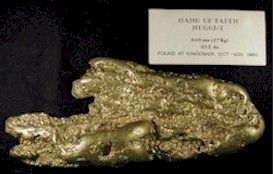

This nugget was found behind the State School in Kingower, Victoria in 1980 with a metal detector by Kevin and Bep Hillier. It weighs 845 troy ounces (about 27.2 kg) and measures 45 by 19 by 10 centimetres.
Despite concerted efforts to keep it within Australia, the nugget was later sold and is on display in the Golden Nugget Casino, Las Vegas, USA.
°. °. °. °.
Schlemm Nugget
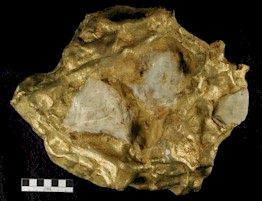

This nugget was found by Henry Davey in Dunolly, at “The Shoots”, near Wilson’s Lead on the 11th of November 1872.
It weighed 538 ounces and measured 31 by 30 by 8 centimetres in size. Quartz was generally mixed throughout the nugget with a little ironstone.
The nugget was subsequently purchased by Mr. Charles Schlemm of Sandhurst.
°. °. °. °.
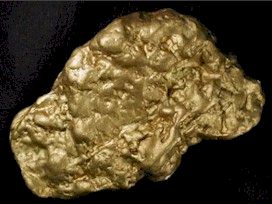

Lady Loch gold nugget
This gold nugget was found on the 23rd of August 1887 by the Midas Mining Company in Sulky Gully Ascot, Victoria at a depth of 114 feet.
The Lady Loch gold nugget weighs 617 ounces and measures 34 by 21 by 7 centimetres.
°. °. °. °.
The Pride of Australia gold nugget
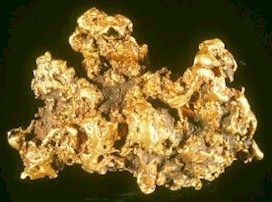

This attractive gold nugget was found at Mosquito Gully near Wedderburn in June 1981. It weighs 256 ounces and is second only in size to the Hand of Faith nugget (above) amongst those nuggets found by metal detector.
It was purchased for $250 000 by the State Bank of Victoria as a gift to the people of Victoria for the State’s 150th anniversary in 1985.
It was displayed in the State Bank, then in the Museum of Victoria, until it was stolen in August 1991. Its fate is unknown.
°. °. °. °.
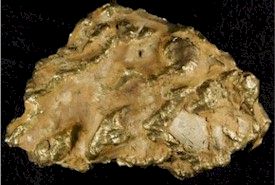

The Little Jack gold nugget
The Little Jack gold nugget was found within the rich Poseidon Lead, Tarnagulla, Victoria, by Jackson and Hughes on the 4th of February 1907.
This 252-ounce nugget measured 22 by 14 by 10 centimetres and was intermingled with a substantial amount of quartz.
°. °. °. °.
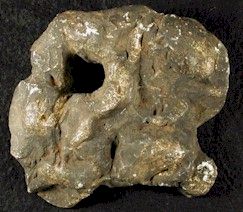

Spondulix gold nugget
This gold nugget was found during November 1872 in Eureka Gully, in the Jordan’s gold field, between Berlin and Wehla, Victoria.
The Spondulix gold nugget was found by Wilton and party and weighed in at 155 ounces, measured 17 by 16 by 5 centimetres. It was also associated with some quartz and ironstone.
°. °. °. °.
The “Beyers and Holtermann Specimen”
The world’s largest single mass of gold is technically not a nugget – it is a ‘specimen’ known as a ‘matrix’.
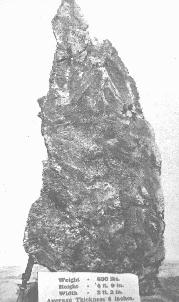

“The Beyers and Holtermann Specimen” is the world’s largest single mass of gold, at an estimated 3,000 ounces.
Beyers and Holtermann were partners in the Star of Hope Mine on the side of Hawkins Hill, Hill End, NSW. Beyers had no physical attachment to the mine while Holtermann became above ground mine manager.
On 19th October, 1872 at 2am a “veritable wall of gold was revealed”.
On 26th October, 1872 The Town and Country Journal reported:
“Holtermann’s landed a specimen last night weighing between 6 and 7 cwt., supposed to contain 2 cwt. of gold. More in the bottom. Great excitement.”
A few months later a larger specimen was found at Hill End, but the miners broke it up underground not wanting all the work of bringing another massive amount of gold to the surface only to see it broken up and smelted.
The “Cannibal Queen” Nugget
Discovered in California in the 19th century, the “Cannibal Queen” was one of the largest gold nuggets ever found in the United States. It weighed 107 troy ounces (3.3 kilograms).
These nuggets are extraordinary examples of the incredible natural wealth that can be found in gold-rich regions, and they hold significant historical and monetary value. While many large nuggets have been discovered and documented, the rarity of such finds makes them prized specimens for collectors and investors alike.
Pepita Canaã
Unearthed in Brazil in 1983, the Pepita Canaã is one of the largest gold nuggets ever found in the world, weighing 134.1 troy pounds (60.82 kilograms).
The Boot of Cortez
Discovered in Mexico in the 1980s, the Boot of Cortez is a large gold nugget that weighed 389 troy ounces (12.1 kilograms). It was shaped like a cowboy boot and is now on display at the Natural History Museum of Los Angeles County.
The world’s richest gold fields
The world’s richest mile is at Kalgoolie in Western Australia, the world’s richest quarter mile is the Rose of England zone, Hill End, NSW.
Nuggety Gully on the side of Hawkins Hill, Hill End, is a 200 metre blind gully which reputedly yielded more gold in a shorter time than anywhere else.
The greatest amount of gold from the smallest amount of quartz was from Paxton’s Mine, Hawkins Hill, 1872. Two tons of quartz was officially crushed at the Vickery Stamper Battery with the recorded yield being 4,200 ozs.
The world’s richest goldfields was discovered by an Australian digger, George Harrison, who in 1886 discovered gold in Witwatersrand, South Africa. His discovery became known as the “Central Rand Gold Field”.
Witwatersrand, locally known as The Rand, produced so much gold that South Africa’s currency was called The Rand in 1961.
South Africa has produced one third of all the world’s known gold mined since the Middle Ages, from depths of over four kilometres below the surface.
The world’s richest single gold mine is in an area known as Ironstone Mountain in Queensland, prospected by the Morgan brothers in 1882. Every ton of ironstone crushed yielded gold.
Re-named Mount Morgan, it is the richest single gold mine in the world, producing payable quantities of gold longer than any other mine in Australia.
°. °. °. °.
The troy system is used to measure weights of precious metals such as gold, and has units of ounces, pennyweights and grains. A troy ounce contains 20 pennyweights and 1 pennyweight contains 24 grains. One troy ounce is equivalent to 31.1 grams in the metric system.
Further Reading
A Guide to Finding Gemstones, Gold, Minerals & Rocks, 2014, by W. Dan Hausel
Hunting Gold, Minerals, Fossils and Artifacts in Alabama, 2019, by Wayne Ruple
Gold, Mineral & Gemstone Prospecting Log Book, 2023, by CPAT Advertising
Gold Detecting for the More Serious (Gold Prospecting Guides – Stephen Barnham), 2004, by Stephen Barnham
Gold Prospecting in Western Australia, 2004, by Rob Kanen
Gold Prospecting Techniques, 2004, by Rob Kanen
I may earn a small commission in affiliate fees from any sales of the above bookss
See our other feature stories on Collectibles:
Our Numismatic coin and bank note feature stories are here
GI Joe – The doll for boys that put action into “action figure”
Police Ephemera ° The value of Victorian reward posters
Postcard collecting ° Deltiology ° Propaganda Postcards of WWI & WWII
The world’s first Christmas card caused a controversy
Numismatics: Fake Coins to Watch For
What to collect in Barbershop Memorabilia

